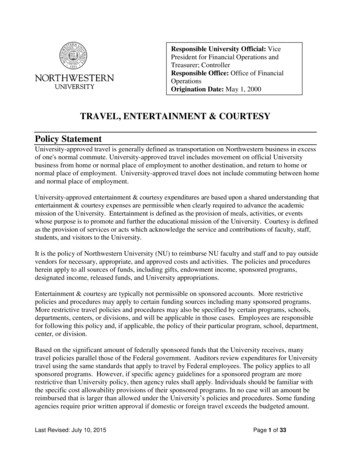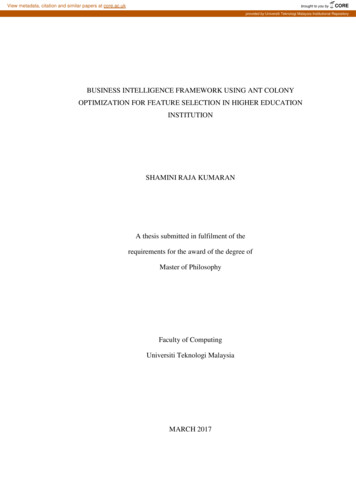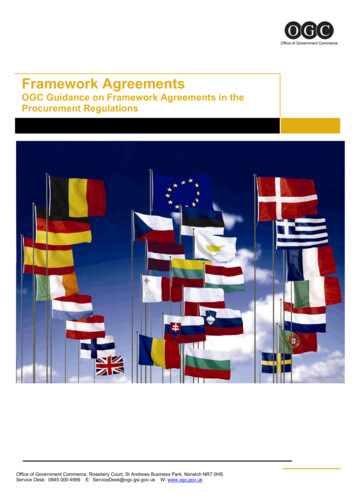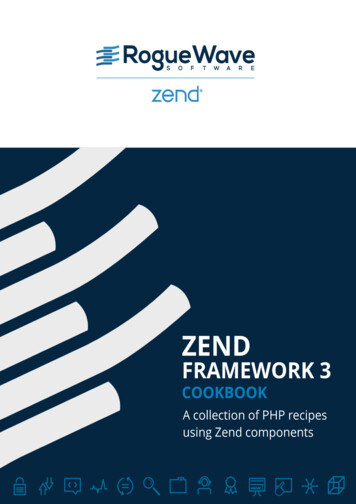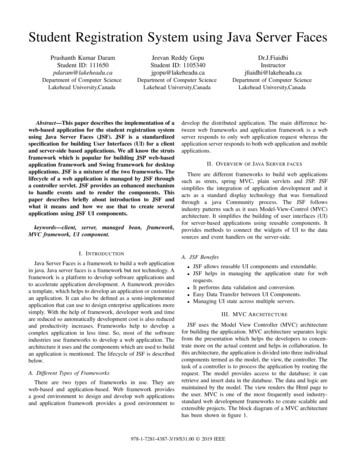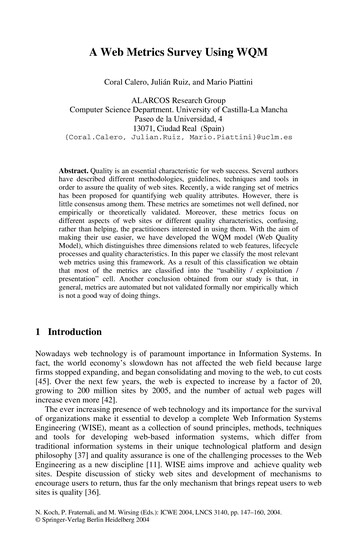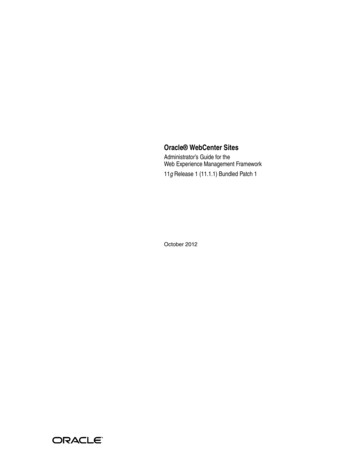
Transcription
A Research Framework for the Smartphone-BasedContextual Study of Mobile Knowledge WorkMikko Heiskala1, Eero Palomäki2, Matti Vartiainen2, Kai Hakkarainen3,and Hanni Muukkonen41Aalto University, School of Science,Department of Computer Science and Engineering, Helsinki, Finlandmikko.heiskala@aalto.fi2Aalto University, School of Science, Department of Industrial Engineering and Management,Work Psychology and Leadership, Helsinki, niversity of Turku, Department of Education, Turku, Finlandkai.hakkarainen@utu.fi4University of Helsinki, Faculty of Agriculture and Forestry, Helsinki, Finlandhanni.muukkonen@helsinki.fiAbstract. We present an initial research framework for the contextual study ofmobile knowledge work that combines automatic, objective data collectionfrom smartphone sensors with subjective participant self-reported data possiblycomplemented with researcher conducted interviews. The framework showshow raw sensor data, contextual information inferred from the sensor data, bothin real-time and post hoc, can be used in tandem with smartphone administeredquestionnaires and post hoc in-depth interviews to study mobile knowledgework. We evaluate the framework by reporting some early experiences from apilot study of mobile knowledge work.Keywords: mobile sensing, mobile data collection, mobile knowledge work,context-awareness, smartphone-based research.1IntroductionThe everyday activities and work of many knowledge workers and other professionalsincreasingly take place in a turbulent national and international environment. Ratherthan following a regular and well-defined path, the professionals have to go throughnumerous transitions across job descriptions, positions, and moving from oneworkplace or enterprise to another. New groups of professionals are emerging whoare doing mobile and multi-locational work; a knowledge-intensive activity thatinvolves the use of sophisticated information and communication technologies (ICTs)at various places (at workplace, in transition, at places provided by customers, atpublic places and at home) during a day or week. Professionals who pursue suchdemanding mobile knowledge work often also function and work in a complex socialA. Marcus (Ed.): DUXU 2014, Part II, LNCS 8518, pp. 246–257, 2014. Springer International Publishing Switzerland 2014
A Research Framework for the Smartphone-Based Contextual Study247context under severe time constraints. These characteristics affect the work itself, itsflow, and the experienced stressfulness and wellbeing at work.Everyday activities of knowledge workers in general, and mobile workers inparticular, take place at boundaries between work, family, and recreational activities.The activities, or their effects on wellbeing, cannot be properly investigated byrelying on traditional methods of location-fixed participant observation(ethnography). Shadowing their activities across contexts would not be practical. Yet,in order to have a thorough view of a professional’s daily life, it is important to tracehis or her activity in its authentic contexts that are often heterogeneous, partiallyunpredictable, and changeable in nature. Questionnaires, retrospective interviews, andlaboratory experiments are valuable, but they often fail to capture real actions of realpeople in real life. When asked about their behavior, people are prone to giveresponses biased towards overestimating their positive traits and underestimating thenegative or responses that are socially desirable. To overcome these challenges novelresearch methods and tools for tracing professional activity are needed. However, thesame technical developments that have led to the emergence of mobile knowledgework have also opened up promising opportunities for research method and tooldevelopment.The current smartphones are powerful, programmable computing devices. They areembedded with a plethora of sensors that can automatically and unobtrusively collecta lot of rich information about the device usage and its immediate surroundings.Smartphones can be used both to administer and answer survey questionnaires on themove, in situ. Given their global popularity and the relative ease of distributingresearch applications it is possible to reach even global scale sample sizes. The richcapabilities that smartphones and their sensors have for the data collection and studyof varied phenomena has been noted recently [1-5]. Their potential in different kindsof social and behavioral research has been addressed by several investigators [6-10].In computer science and engineering, context-aware computing, i.e., computationalsystems that are aware -or sense- the setting and environment they are used and adapt tothose conditions, has been a hot topic for at least a decade. A widely cited definition forcontext is the following [11]: “Context is any information that can be used tocharacterize the situation of an entity. An entity is a person, place, or object that isconsidered relevant to the interaction between a user and an application including theuser and the application themselves.” Both the technical capabilities for collectingsensor data about contexts and the algorithms to infer specific semantic contexts fromthe sensor data are developing rapidly and becoming available even on the commercialsmartphone operating systems. For researchers interested in human behavior, contextawareness enables automatic data collection about the context of the device and its user.If the context can be inferred immediately, the information could be used to launchcontext-specific questionnaires [12]. This allows contextual sampling of experiencesand events of people’s daily life. Automatically collected data from smartphones cancomplement and validate self-reported data and to support more in-depth interviews.These tools and technologies seem particularly useful for the study of mobileknowledge work but can also be useful for the study of a wide range of otherphenomena, especially in studying the daily life and experiences of people.
248M. Heiskala et al.In this paper we present a smartphone-based research framework for the contextualstudy of mobile knowledge work that combines automatic, unobtrusive, and objectivedata collection from smartphone sensors with subjective participant self-reported datapossibly complemented with researcher conducted interviews. The researchframework shows how raw sensor data, contextual information inferred from thesensor data, both in real-time and post hoc, can be used in tandem with smartphoneadministered (context-specific and/or context-agnostic) questionnaires and in-depthinterviews to study mobile knowledge work. We evaluate the framework by reportingexperiences from a small pilot study of a group of mobile knowledge workers.The rest of the paper is structured as follows. Next, we describe mobile sensing ofcontexts. In section 3 we present the research framework which we then demonstrateand evaluate in section 4. Discussion and our conclusions end the paper.2Mobile Sensing of ContextsFor many their personal smartphone is their most important communication andcomputational device. They use it throughout the day, every day, and carry itwherever they go. The smartphones are often equipped with many sensors like GPS,accelerometer, gyroscope, camera, microphone, magnetic field, ambient light, andtemperature. As smartphones are programmable, device interaction and data contentscan be ‘sensed’ as well. These could include running applications, screen orientation,cell tower ID, call and SMS logs, contacts and calendar entries, to name a few.While useful for many purposes, the raw sensor data as such is considerably lessuseful for the study of mobile knowledge work. In most cases, the raw sensor data needsto be interpreted as human behavior (e.g., walking, sitting, talking) or as a particular,meaningful context of the person (e.g., being at home, at work, at a cafe, in a bus, or anoise level of environment) to be useful, although the raw data could be used to validatesome of participants’ self-report or interview data. An expanding amount of research isbeing directed to the development of software tools and algorithms for using sensor datato automatically recognize activities and contexts [2-3].The development of context recognition algorithms and their implementation onthe phones is a challenge. Combined with possibly multimodal data collection fromthe phone sensors, the potentially computationally complex context inferencealgorithms can be energy hungry. This is a challenge because of the limited batterypower of smartphones. This can be partially solved by offloading all or some of theinference algorithm computation to the cloud if a network connection is available.However, this also consumes energy and might hike up data costs for the participant.Moreover, from the research point of view, one of the main challenges in smart phonedata collection is the need to transmit data via networking to servers. Although globalInternet is growing, in large parts of the globe the access to networks is still meagreand require stand-alone devices for data collection.Many of the algorithms require ‘training data’, i.e., data labeled by the user tocorrespond to a certain physical activity (such as walking) or context (such as being ina bus). Any mobile sensing research tool probably needs to enable training of sensing
A Research Framework for the Smartphone-Based Contextual Study249algorithms by categorizing and labeling activities. Individual differences and themyriad situations where activities and contexts occur mean they can become blurred(e.g., standing in a bus). This makes the reliable algorithm development challenging.Table 1. Mobile knowledge work context framework (adapted from [4])PersonalEnvironmentalEnd onSensedTalk patternsBiofeedbackfrom connectedexternal sensors(heart rate,blood pressure)DerivedAt sleep/awakeHealthconditionStress es(like gym,meeting)User TemperatureNoise levelAmbientlightBattery levelSignal strengthAccessalternativesGPScoordinatesCell onNetworkqualityDeviceoperating rangeSemanticplace (e.g.,home,office)TransportTime(all of the above, their state and changes, can be described as a snapshot in time or a period of time)Day of week, weekend, time of day, etc.Nevertheless, many activities and contexts can be identified continuously, or posthoc, from the collected sensor data, either automatically or with some categorizedtraining data. Some of higher-level activity and context detection functionality isbecoming available on commercial smartphone platforms in the form of APIs(application programming interface). For example, as of Google I/O developerconference 2013, Android’s Google Play Services Location API includes functionalityfor instant and continuous activity recognition (whether the phone is still, walking,cycling, or in-vehicle) and also for setting up geofences (i.e., geographic boundariesaround some interesting location) and then receiving notifications when the phonecrosses the geofence. This could, for example, be used to follow how much time aperson spends at home or at the office. Although smartphone platforms will surelyprovide more such context-awareness functionality in the future, it is probable that theywill cover only a subset of activity and needs and possibilities of context identificationinteresting for the study of mobile knowledge work.Context is a multifaceted concept and can refer to many a thing. Soikkeli et al. [4]provide a useful framework to categorize contexts that is geared to handset-based datasources. The framework divides contexts into the broad categories of Personal and
250M. Heiskala et al.Environmental. Personal contexts are further categorized as End User, SocialEnvironment, and Activity/Task while Environmental contexts are divided intocategories of Conditions in the immediate physical environment of the person,Infrastructure i.e., computational infrastructure available for the user, and Locationi.e., not just the point on a map. In addition to Personal and Environmental theframework includes Time as the third broad category. Researchers might be interestedin a snapshot of contexts in time or over a time period. The sensor data collected fromsmartphones typically has a timestamp attached to each data point. The researchersmight analyze the past (context history), the present (current context), or the future(predicted context). The framework also adds a categorization dimension for contextsaccording to the data source used to determine the context. The data sources are:Profiled, i.e., user self-reported data, which could include labeling data discussedabove, research questionnaire answers, and any information inputted by the userotherwise like e.g., phone calendar entries; Sensed, i.e., direct automatic sensormeasurements; and Derived, i.e., context inferred via algorithms or otherwise basedon Sensed and/or Profiled data.Table 1 presents a context framework for mobile knowledge work (adapted from[4]) with some relevant context examples in each category. Examples in the Derivedcategory also show what kind of contexts can currently be inferred based onsmartphone sensor raw data. However, to the best of our knowledge there currentlyare no research toolsets that would have recognition algorithms for all of these.3A Research Framework for Contextual Study of MobileKnowledge Work3.1OverviewIn this section we present a smartphone-based research framework for contextualstudy of mobile knowledge work that combines mobile sensing and user self-reportquestionnaires with possible in-depth interviews. Depending on the researchobjectives, the framework can be adapted to include multiple combinations ofcontexts studied, data sources and sampling strategies used, and study lengths. Wealso discuss requirements for tool support but do take a future-oriented view inanticipating rapid progress in research tools that include an expanding range ofautomatic context-sensing functionality. We assume the toolset enables researchers tocollect information about the contexts of a knowledge worker over time automatically(via sensing) and via user input (profiled) which also could be used to train thealgorithms to identify contexts automatically. The toolset should also enableresearchers administer traditional survey questionnaires via the smartphone.3.2Research Design IssuesWhen designing smartphone based contextual research, several issues need to beconsidered carefully as there are several tradeoffs involved related to the smartphone
A Research Framework for the Smartphone-Based Contextual Study251energy consumption, privacy, the burden placed on participants, and the amount ofdata generated vis-a-vis the research needs, data sources, and sampling rates used. Ifpoorly designed, it can lead to participants dropping out of the study and to a poorquality data. We will discuss some of these issues below.Energy Consumption and Smartphone-Based Sensing. Any measurement takenfrom the phone will consume its battery. However, some sensors are more energyhungry than others. These problems are highlighted because the research applicationsare likely to be installed on the participants’ personal or work phones instead of anadditional research device. The participants will surely be annoyed if the researchapplication consumes so much battery power that it interferes with their normal phoneusage. The research design should take energy consumption into account whendeciding the sensors and the sampling rates used. For many purposes, continuoussensing is not necessary. Energy consumption can also be driven higher if there is aneed to upload data to a cloud server.Privacy. When the research is done on the participants’ personal phones protectingtheir privacy is critical. Data transfer and storage must be secure. The participantsmust be made aware of what data is collected, what it will and can be used for as thepossibility to infer contextual information from raw sensor data is not obvious to alayperson, how long it is stored for, etc. Another privacy problem is that smartphonedata collection may indirectly collect information about other people who have notgiven their informed consent.Burden on Participants. Automatic data collection from sensors does not put anyadditional burden on the participants directly but is does consume battery power. Theparticipants may need to charge their phone more frequently than they are used to oris convenient for them.Naturally, any data collection that requires user input burdens the participants.Training data collection for context detection algorithms in the beginning of a study islargely unavoidable as the data is necessary for the algorithms to function properly.The burden from the manual inputting of contexts or activities can be balanced bylimiting the number of contexts or activities logged.Answering research questionnaires is the more burdensome the more often theparticipant needs to answer them. A balance must be struck between samplingfrequency and questionnaire length. If the sampling is based on detected contexts oractivities the participant might be prompted to answer the questionnaire in very quicksuccession, which could be irritating especially if the questionnaire is long. Theresearch toolset should limit how often the participant has to answer a questionnairewithin a timeframe and how soon the participant needs to answer the questionnaireagain.Amount of Data Collected. Mobile sensing can yield a surprisingly large volume ofdata. This causes a few challenges for the research design. First, the local data storageon a smartphone has its limits. In a longer study it might be filled – to the undoubted
252M. Heiskala et al.irritation of the participant – and subsequent data lost if the collected data is nottransferred elsewhere from the device in a planned manner. Second, the continuousdata transfer adds also drains the battery. And third, if data transfer is done over amobile network, it might cause a huge phone bill for the participant (or the researchproject). To avoid this, the data transfer should be done over WLAN connection. Insmaller studies, manual data transfer via physical data cables can be feasible.Participant Sample Sizes and Data Collection Methods. The smartphone-basedcontextual study allows mixed-method research designs combining mobile sensing,questionnaires, and interviews [15]. Automatic sensing is the least labor-intensivedata collection method and could therefore include the whole group of participants.As collecting self-report data, whether context-labeling or questionnaire answers, isburdensome for the participants and the analysis of the data more resource-consumingfor the researchers, self-reported data could be collected from a smaller subset ofparticipants. The subset could be selected randomly or purposefully based on mobilesensing data or some background information. Further, as interviewing is moreresource consuming than answering smartphone questionnaires, the sample for anyinterviews could again be smaller and chosen randomly or based on backgroundinformation and mobile sensing and/or questionnaire data.3.3Research and Data Collection PhasesNext, we will discuss the different phases of the data collection in their chronologicalorder. A study following the framework might not include all of the phases.Installing the Research Application on Participants’ Smartphones. First, theresearch application including the mobile sensing and questionnaire functionalitymust be installed on the participants’ smartphones. If the participants are known, theapplication or a link to download the application can be sent to them directly. If theparticipants are unknown, the link to download the application can be distributed onthe web or the application can be included in the mobile application stores likeGoogle Play or Apple AppStore.Pre-Study Survey. A pre-study survey could include questions on demographics andother background information. Further, it could include items and measures that canbe used in pre- and post-test (or before-after) type of analysis. Answering the surveycould be required before other data collection would begin.Training Period for Labeling Data for Learning Algorithms. A period ofcollecting labeled training data for context inference learning algorithms is required.Depending on the research objectives, the more comprehensive data collection mightbegin simultaneously or after this phase.Data Collection. This phase can combine automatic sensing, and participant selfreporting via questionnaires and categorization of contexts.
A Research Framework for the Smartphone-Based Contextual Study253Post-Study Survey. A post-study survey done after the data collection period wouldsupport before/after type of analysis.Interviews. As discussed earlier, mobile sensing and questionnaire data could besupported with in-depth retrospective qualitative interviews with a subset ofparticipants. The interview could be supported by an initial analysis mobile sensingand questionnaire data of the participant. Continuously sensed data about the contexts,activities, and locations of the participant during the research could provide a usefulmemory anchor for the interview or for user diaries following the Day ReconstructionMethod [13] or the method of stimulated recall.Analysis of Data and Results. Naturally, data analysis is the last phase. This phasecan include deriving interesting information, like contexts and activities, from thecollected raw sensor data.4Pilot Study Experiences4.1Overview and ToolsetWe conducted a pilot study following the research framework to study mobileknowledge work of a sample of 8 academic professionals during one work week, i.e.,five consecutive working days but not necessarily from Monday to Friday. The toolsetwe used included two research applications that have been developed separately:Contextual Activity Sampling System (CASS-Q) for self-report questionnaires andContextLogger3 for collecting sensor data and context and activity labeling.The CASS-Q system was originally developed as a Java application for Symbianphones [14] but the current version of the CASS-Q client 1 runs on the Androidoperating system. The questionnaires are created on the management system whichruns as a cloud service. The questionnaires can include a wide range of questions likeopen ended and multiple-choice questions, questions with different numerical scales,e.g., Likert, and recording audio answers or taking photographs.ContextLogger3 2 [15] is a research application running on Android that allowsresearchers to collect smartphone sensor data on the background and participants toself-report context and activity labeling data via logging their start and stoptimestamps. The sensor data collection functionality in ContextLogger3 is based OpenSensing Framework FUNF (funf.org) developed at MIT Media Lab [16]. For thepilot, we integrated the tools so that ContextLogger3 launched a CASS-Qquestionnaire after a participant self-reported a change in his or her activity.This allowed context-contingent sampling for the questionnaires, albeit relying onself-reported contexts.12CASS-Q client in Google Play: https://play.google.com/store/apps/details?id fi.metropolia.cass.mainContextLogger3 source code: https://github.com/apps8os/contextlogger3
2544.2M. Heiskala et al.Research Design of Pilot Using the FrameworkWe limited the drain on the battery power by only taking collecting sensor data aboutthe location using GPS coordinates and mobile network cell ids. The sampling rate wasalso conservative. This did also limit the amount of sensor data collected. We did notcollect any data that could have compromised third party privacy, e.g., call logs orBluetooth pairings. The participants were informed of the purpose of the study and whatdata was collected with particular care placed on informing them about sensor datacollection. Each participant was asked to log the changes in their location and activitycontexts throughout the day using ContextLogger3. After each change in their activity,the participants were prompted to answer a CASS-Q questionnaire 20 minutes later andsubsequently in intervals of 60 minutes if the activity remained the same. Table 2 showsthe contexts we collected data about, and the tools and methods used. CASS-Q data wasuploaded to the management system after each questionnaire over either a WLAN ormobile network connection the smartphone was connected to at the time. Ourparticipant group was not large enough to divide data collection burden amongst thegroup so we treated all of them equally in data collection with exception of retrospectiveinterviews. We interviewed only a subset of the participants but this was more due tothe ease the burden on researchers than the participants.Table 2. Pilot data collection about contexts of mobile knowledge workPersonalEnd userProfiledQuestionnaire forwork flowand e /Research /Teaching &Supervising /Societal Activity /Other(ContextLogger3)Open antic places:Home / Work /Customer / Publicspace / Transport(ContextLogger3)Open question(CASS-Q)GPS, cell iaphotograph(CASS-Q)Indirectly viaphotograph(CASSQ)Validation ofchanges in profiledlocation withsensed locationdataTimestamps (time of day and date) were stored for each sensor reading and user self-report via bothContextLogger3 and CASS-Q. This allowed us to analyze the duration of activities and time spent at thelocations. Also, we used the timestamps to map flow and affect of work questionnaire answers from CASS-Q tothe corresponding locations and activities reported via ContextLogger3.
A Research Framework for the Smartphone-Based Contextual Study4.3255Phases of Data Collection in the PilotThe participants downloaded and installed CASS-Q from Google Play while a versionof ContextLogger3 with the specified location and activity contexts was downloadedfrom a separate web link. The participants then entered the unique identifier tokenthey had received into CASS-Q and were then ready to begin data collection. We didnot do pre- or post-study surveys. As ContextLogger3 does not include automaticinference of context from sensor data, we did not need to include a period of labelingtraining data for learning context inference algorithms either. After data collection,the activity and location context data from ContextLogger3 was used to createdescription of the working days of the participants. These were used in retrospectiveinterviews with a subset of the participants. In the analysis phase we used theautomatically collected sensor data to validate the self-reported changes in locations.4.4Experiences and EvaluationThe overriding conclusion from the pilot is that smartphone-based contextual researchis a very promising and apt approach to study mobile knowledge work. We are still inthe process of analyzing some of the data. Even such a short and small study like thisresulted in rich and varied data that we could not have collected via traditionalmethods and tools. However, several challenges remain. Smartphones have differenttechnical capabilities, run different versions of the operating system – or a different,incompatible with research application, and participants have data plans that differ inpricing and availability. We faced some problems with all of these issues in the pilot.We would assume the problems to be much bigger for a global study with largersample sizes. While we collected the data successfully, its analysis still needs a lot ofmanual work. Raw sensor data needs to be cleaned from errors and transformed toformats used in common research tools.5Discussion and ConclusionsOur research revealed that mobile and multi-locational work can productively bestudied by the smartphone-based research framework. In order to trace theincreasingly turbulent, complex, and heterogeneous practices and contexts of mobileknowledge work, such new context and process sensitive methods are needed. Wealso show that the socio-digital technologies that increasingly mediate all aspects ofmodern work provide also instruments and methods for contextually tracingdistributed personal and professional activities.Yet, to transform the promise of smartphones as research instruments to reality, agreat deal of research and development have to be carried out so as to have thefollowing implemented in a single research toolset: full integration of automatic andself-report data collection; productive use of the smartphone sensor architecture whilesolving the associated energy consumption problems; implementing the algorithmsfor automatic context recognition being developed elsewhere; and d) effectiveanalysis and visualization of large and complex bodies of time series data for
256M. Heiskala et al.purposes of scientific analysis and user feedback. Such a new generation researchframework would allow more or less intelligently recognizing relevant contexts anduse context-awareness for automatically activating queries [12]. To conclude, ourlong-standing strategic objective is to provide such a toolset for contextual andprocess-sensitive research in social and engineering sciences.In social sciences, the method, so to speak, creates the phenomenon ( researchobject) investigated. The research instruments used de
A Research Framework for the Smartphone-Based Contextual Study 249 algorithms by categorizing and labeling activities. Individual differences and the myriad situations where activities and contexts occur mean they can become blurred (e.g., standing in a bus). This makes the reliable algorithm development challenging.

